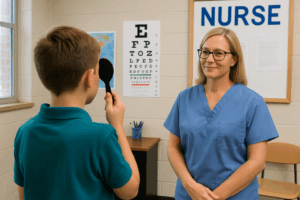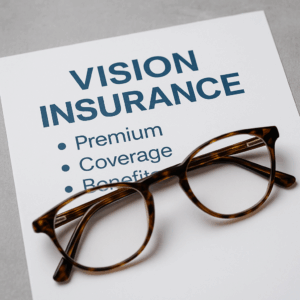Introduction
We’ve discovered something quite alarming—nearly 11 million Americans over age 12 need vision correction they simply don’t have. Your yearly eye examination offers so much more than just updating your prescription. It’s a vital health assessment that might actually save your vision. Many eye conditions progress quietly without giving any warning signs, which makes your regular visits essential for catching problems before permanent damage occurs.
Cataracts currently stand as the leading cause of vision loss across the United States, while diabetic retinopathy remains the primary reason for blindness among American adults. Scheduling your eye examination shouldn’t wait, especially knowing early detection can prevent or delay blindness for 90% of people living with diabetes. The modest cost of an eye check-up pales when compared to treating advanced eye diseases or dealing with how poor vision might affect your job performance and everyday activities. Your vision insurance makes these essential check-ups even more affordable, helping ensure your eye health—and your overall wellbeing—stays protected from conditions we can often prevent together.
Your Vision's Role in Daily Life
Your eyes quietly power nearly everything you do throughout your day. Think about it—from the first morning light until you drift off to sleep, your eyesight creates your connection to the world. While hearing and touch certainly matter, your vision actually delivers about 80% of the information you gather about your surroundings each day.
How vision affects work, driving, and learning
Sharp eyesight directly influences your success at work.  Clear vision helps you process information quickly and accurately when you’re reading reports, looking at computer screens, or participating in meetings. Research shows that employees struggling with uncorrected vision problems might lose up to 15 minutes of productive work time every day, time that adds up quickly.
Clear vision helps you process information quickly and accurately when you’re reading reports, looking at computer screens, or participating in meetings. Research shows that employees struggling with uncorrected vision problems might lose up to 15 minutes of productive work time every day, time that adds up quickly.
Your safety on the road depends heavily on good vision too. Seeing distances correctly, reading street signs, and spotting potential dangers all rely on healthy eyes. Drivers whose vision isn’t optimal face greater accident risks, potentially leading to higher insurance costs and even legal complications.
Students at every age need good vision for academic success. Whether they’re reading textbooks, taking notes, or watching presentations, their learning depends on seeing clearly. We often find children with undiagnosed vision issues struggle in school and might even be incorrectly labeled with learning disabilities when the real problem is simply that they can’t see properly.
Poor vision creates financial challenges beyond just health concerns. When your eyesight falters, you might face:
- Reduced work performance that limits your earning potential
- Extra costs from accidents or mistakes
- Lower quality of life requiring additional expenses
Finding a convenient eye examination location becomes even more important when you consider these impacts. Regular visits help us catch vision changes before they significantly disrupt your daily life.
Signs your eyesight may be declining
Noticing vision changes early allows us to address problems quickly. Watch for these warning signals that suggest it’s time for an eye check-up:
Physical discomfort signals:
- Headaches that come after reading or screen time
- Eye tiredness that gets worse as your day progresses
- Ongoing burning, itching, or dryness in your eyes
Visual function changes:
- Holding reading materials or objects such as your phone screen farther away to see them clearly
- Trouble seeing at night or when lighting isn’t bright
- Needing more light for reading than you used to
- Needing to adjust your screen brightness and proximity to see your screen better
Performance indicators:
- Difficulty recognizing familiar faces from a distance
- Overlooking small details you would have noticed before
- Accidentally bumping into things or misjudging distances
- Declining ability to drive at night
Many patients brush these symptoms off as just normal aging or being tired. These signs often point to treatable vision conditions that, when caught early, won’t continue getting worse.
The modest cost of your eye examination pales in comparison to how declining vision might affect your career, personal safety, and everyday enjoyment. Most vision insurance plans include yearly comprehensive exams, making preventive care quite affordable. Using your vision benefits reduces what you pay while helping maintain your best possible eyesight.
Some online vision screening options might seem convenient, but they simply can’t replace a thorough in-person assessment that evaluates both how well you see and your overall eye health. Only a complete examination by our eye care team can detect subtle changes that might signal developing eye conditions needing early treatment.
Putting off eye care when symptoms appear typically leads to more complicated and expensive treatments down the road. Your regular eye examinations represent a true investment in both your health and financial future.
What an Annual Eye Exam Can Reveal
Your yearly eye examination works like a window into your overall health, showing us much more than just vision concerns. Our eye care specialists can spot numerous health conditions during a thorough evaluation of your eyes—often before you feel any symptoms at all.
Detecting early signs of eye diseases
Many serious eye conditions quietly develop without warning, causing permanent damage before you notice anything wrong. During your dilated eye exam, we can identify early signs of potentially blinding conditions:
During your dilated eye exam, we can identify early signs of potentially blinding conditions:
Glaucoma, commonly known as the “silent thief of sight,” typically shows no early warning signs while gradually damaging your optic nerve. Most people don’t notice vision changes until permanent harm has already occurred. Thankfully, our routine eye exams measure pressure inside your eye and can catch early signs of optic nerve damage.
Age-related macular degeneration (AMD) affects the central portion of your retina, making it challenging to see fine details, read books, or recognize familiar faces. Your comprehensive exam helps us identify subtle retinal changes that signal the beginning stages, allowing for early care that helps preserve your central vision.
Diabetic retinopathy harms blood vessels in your retina and typically advances without symptoms until your vision becomes threatened. Regular thorough exams prove essential for catching the earliest signs of retinal damage, especially if you live with diabetes.
Regular thorough exams prove essential for catching the earliest signs of retinal damage, especially if you live with diabetes.
Finding these conditions early through regular eye check-ups allows for timely treatment, greatly improving your outcomes and potentially saving thousands in treatment expenses down the road.
Spotting other health issues like diabetes or hypertension
Beyond eye-specific concerns, your eye doctor can identify signs of broader health issues during a routine visit:
- Diabetes – Changes in your retinal blood vessels might reveal early signs of diabetes, sometimes even before your primary care doctor makes the diagnosis
- Hypertension – Narrowed or leaking blood vessels in your retina could signal high blood pressure
- High cholesterol – Yellowish deposits around your cornea or cholesterol blockages in retinal blood vessels often indicate elevated levels
- Cardiovascular issues – Changes in your eye blood vessels frequently mirror damage happening in other organs
Our eye doctors have detected life-threatening conditions during what seemed like ordinary check-ups. One notable case involved an optometrist who noticed a flame-shaped hemorrhage in a patient’s retina, indicating dangerously high blood pressure. This discovery led to emergency heart bypass surgery, likely saving the patient’s life.
Why online eye examination is not enough
While online vision tests might seem convenient and budget-friendly, they simply cannot replace an in-person examination with our specialists. The American Optometric Association confirms that online tests mainly measure visual acuity and estimate prescription needs—they don’t properly evaluate your eye health.
These critical elements missing from online tests include:
- Dilated eye examination – Lets us clearly see the back of your eye, revealing blood vessels that might indicate conditions like high blood pressure or cholesterol issues
- Microscopic examination – Evaluates your eye structures for cataracts and other conditions
- Pressure testing – Measures the pressure inside your eyes to detect glaucoma
- Professional expertise – Our trained specialists can notice subtle changes that automated tests simply miss
Choosing online exams instead of visiting us in person can have serious consequences. When conditions remain undetected for extended periods, your chances for effective treatment decrease, potentially leading to vision loss that could have been prevented.
The modest cost of your eye examination seems small when compared to treating advanced eye diseases or managing health conditions discovered too late. Most vision insurance plans cover yearly comprehensive exams, making this essential care quite accessible. Your regular in-person visits represent both a health investment and financial protection against costly treatments you might otherwise need later.
Symptoms You Shouldn't Ignore
Noticing warning signs from your eyes could mean the difference between keeping your sight and facing permanent vision loss. Quick action becomes essential when certain symptoms appear—delays might lead to serious consequences for both your vision and your financial wellbeing.
Blurry or double vision
Unexpected blurry vision or seeing double needs your immediate attention, as these symptoms often point to serious conditions requiring quick intervention. You might initially brush off temporary blurriness as simple tiredness, but ongoing issues can signal concerning problems such as:
- Diabetic retinopathy damaging blood vessels in your retina
- Cataracts gradually clouding your natural lens
- Vision changes related to stroke needing emergency medical care
Double vision particularly might indicate neurological concerns or eye muscle difficulties. Quickly finding an eye examination near you when experiencing these symptoms helps prevent permanent vision damage while avoiding expensive treatments later. Your vision insurance typically reduces emergency appointment costs dramatically compared to treating advanced conditions.
Quickly finding an eye examination near you when experiencing these symptoms helps prevent permanent vision damage while avoiding expensive treatments later. Your vision insurance typically reduces emergency appointment costs dramatically compared to treating advanced conditions.
Floaters, flashes, or halos
Those occasional floaters, tiny specks drifting across your sight, usually don’t cause harm. However, a sudden increase in floaters, especially alongside flashes of light, calls for immediate professional assessment as it might signal a retinal tear or detachment.
Halos appearing around lights, particularly during nighttime, often indicate cataracts or corneal swelling. Left untreated, these conditions steadily worsen, potentially affecting your ability to drive safely and perform well at work. Beyond the health concerns, reduced visual function often leads to decreased productivity and earning potential—making your eye examination cost quite small compared to what you might lose.
Eye pain or redness
While not every eye pain means trouble, certain situations deserve urgent care:
- Severe pain with redness and sensitivity to light
- Pain that comes with vision changes
- Eye pain alongside headache and nausea
These symptoms might point to conditions ranging from corneal scratches to acute glaucoma—with the latter needing emergency treatment to save your vision.  Just as important, ongoing redness with discharge might indicate conjunctivitis or more serious infections.
Just as important, ongoing redness with discharge might indicate conjunctivitis or more serious infections.
Knowing exactly where to find eye care professionals becomes vital during these urgent situations. Though online resources provide helpful information, they simply cannot replace professional evaluation for worrisome symptoms. Your vision insurance offers valuable financial protection precisely when unexpected eye problems arise.
Remember, addressing symptoms quickly usually means simpler, more affordable treatments. Waiting too long often leads to complicated procedures, longer recovery periods, and possibly permanent vision damage affecting nearly every part of your daily life and financial health.
Where and How to Get an Eye Exam
Finding the right eye care starts with knowing where to look for qualified professionals you can trust. Your regular eye examinations represent valuable investments in your long-term vision health, not just simple appointments to update your glasses prescription.
Finding an eye examination test near me
When searching for an eye care provider, several reliable resources can guide you:
- Search for an eye care provider with a comprehensive blog and social media presence. This gives you a good insight into their best practices and services.
- Call your vision insurance company for their list of in-network eye doctors
- Browse online directories offered by professional eye care organizations
- Check reviews to see details on specific styles and feedback from previous patients.
Many vision plans provide helpful online search tools that customize results based on your specific coverage benefits. This thoughtful approach helps you maximize your insurance while keeping your costs low.  Some eye care offices even offer evening and weekend appointments, making it easier to fit your yearly eye exam into your busy schedule without missing work. Boerne Vision Center offers easy online booking and convenient tools such as our easy way to select your eyeglasses online.
Some eye care offices even offer evening and weekend appointments, making it easier to fit your yearly eye exam into your busy schedule without missing work. Boerne Vision Center offers easy online booking and convenient tools such as our easy way to select your eyeglasses online.
What to expect during a comprehensive eye exam
Your thorough eye visit typically lasts between 30-90 minutes, depending on which tests your unique situation requires. During your appointment:
Your eye doctor will carefully review your medical background, current medications, and any vision concerns troubling you. This personal conversation helps identify risk factors that might need special attention during your examination. Following this chat, you’ll experience various gentle tests assessing both your vision quality and overall eye health.
Most eye exams include visual acuity checks, eye muscle tests, side vision assessments, and pupil response evaluations. Your doctor might also measure your eye pressure using tonometry—an essential test for catching glaucoma early. For the most complete picture of your eye health, your doctor may dilate your pupils, allowing a clear view of your retina, optic nerve, and the tiny blood vessels inside your eyes.
Difference between screening and full exam
Vision screenings, sometimes offered at schools or workplaces, provide only basic assessments that catch obvious vision problems. These quick checks mainly test how well you can see, occasionally checking color vision or depth perception.
A complete eye examination delivers so much more value for your time and money. The American Optometric Association notes that simple vision screenings frequently miss complex eye health issues, particularly since many serious conditions don’t affect your vision in their early stages. Even passing a basic screening offers no guarantee that your eyes are truly healthy.
Professional examinations performed by skilled optometrists or ophthalmologists use specialized equipment to thoroughly evaluate every aspect of your eye health. Early detection through these detailed exams allows for more effective treatment options, often saving you significant money compared to treating advanced eye diseases later.
Your optimal vision, maintained through regular exams, also supports your workplace productivity and safety—a valuable financial benefit of proper eye care that many people overlook.
Understanding the Cost of Eye Exams
We know the financial side of vision care often determines whether you’ll schedule that important yearly check-up. Getting familiar with what you’ll pay and finding ways to reduce costs helps make good eye health accessible for everyone.
How much is an eye examination?
Standard eye exams across the United States typically range from $75 to $200 without insurance.  Most people pay around $100 on average, though prices vary quite a bit depending on where you live and which type of eye doctor you see. When you choose comprehensive exams that look at both your vision and eye health, you’ll usually pay between $100 and $200.
Most people pay around $100 on average, though prices vary quite a bit depending on where you live and which type of eye doctor you see. When you choose comprehensive exams that look at both your vision and eye health, you’ll usually pay between $100 and $200.
Your final cost depends on several key factors:
- Exam type – Simple vision tests cost less than thorough evaluations
- Provider – Visits to optometrists usually cost less than seeing ophthalmologists
- Technology used – Extra tests like retinal imaging add $20-$50 to your bill
Using insurance to lower costs
Your vision insurance wonderfully reduces what you’ll pay out-of-pocket, with most co-pays running between $10 and $40 for full exams. This means you might pay just a fifth of the regular price. Plus, many vision plans include one yearly check-up and help with the cost of glasses or contacts.
Take a moment to check if your current health insurance includes vision benefits. While the Affordable Care Act requires pediatric vision coverage for children under 19, most adults need separate vision insurance, which usually costs about $150-$200 per year.
If you don’t have insurance, you still have several good options:
- Medicaid offers vision care in many states
- Medicare helps cover eye care related to medical conditions
- Discount programs through stores like America’s Best provide $45 flat-rate exams
- Community health centers offer fees based on what you can afford
Why regular exams save money in the long run
Putting money into preventive eye care gives you remarkable financial benefits. Catching eye conditions early through regular check-ups helps avoid costly treatments for advanced eye diseases. Spending about $100 yearly could save you thousands in future medical expenses.
Catching eye conditions early through regular check-ups helps avoid costly treatments for advanced eye diseases. Spending about $100 yearly could save you thousands in future medical expenses.
Beyond direct healthcare savings, keeping your vision sharp affects your earning potential too. Poor eyesight reduces workplace productivity—employees struggling with vision problems lose valuable work time every day, which ultimately impacts both your job evaluations and income.
Your regular eye exams can detect over 270 different health conditions, including diabetes—which eye doctors actually identified first (before medical doctors) in 34% of cases. Employees with diabetes save about $1,733 in annual healthcare costs when they get regular eye care, while those with high blood pressure save around $2,633.
When you consider these savings, vision insurance typically costs less than your weekly coffee shop visits, making it a smart investment in both your health and financial well-being.
Conclusion
Caring for your eyes stands as one of the wisest investments you’ll make for your health and financial wellbeing. Throughout our discussion, we’ve explored how your regular eye examinations work as essential preventive measures that go well beyond simply updating your prescription. These thorough check-ups catch serious conditions before they cause permanent damage, potentially saving not just your precious vision but thousands of dollars in treatment costs.
Throughout our discussion, we’ve explored how your regular eye examinations work as essential preventive measures that go well beyond simply updating your prescription. These thorough check-ups catch serious conditions before they cause permanent damage, potentially saving not just your precious vision but thousands of dollars in treatment costs.
The numbers tell a simple story: spending around $100 yearly on preventive eye care might save you thousands in future medical bills. Your vision insurance makes this even more affordable—typically reducing your cost to just $10-$40 per comprehensive exam. Don’t worry if you lack coverage; affordable options await through community health centers, retail chains, and various discount programs.
Neglecting your eye health carries consequences beyond medical expenses. Poor vision affects your earning potential through reduced workplace productivity, more frequent errors, and possible safety incidents.  The modest cost of your eye examination seems tiny compared to potential income losses from vision-related performance issues.
The modest cost of your eye examination seems tiny compared to potential income losses from vision-related performance issues.
Your comprehensive eye exams can uncover signs of over 270 health conditions, including diabetes and high blood pressure, often before other symptoms emerge. Early detection through these visits allows for gentler, less expensive treatment options that preserve your quality of life.
Those convenient online screenings might tempt you, but they simply cannot match the detailed evaluation your eye care professional provides. Only thorough, in-person examinations detect subtle changes signaling developing eye diseases or broader health concerns.
Your vision touches virtually every aspect of your daily life. Making annual eye examinations a priority represents both a health decision and a smart financial choice that protects your sight and your wallet. Schedule your next eye exam today—we promise your future self will thank you for your wisdom and foresight.


